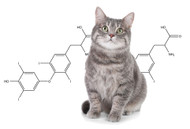Hyperthyroidism in Cats
29th Aug 2023

A common concern in cat owners is known as Hyperthyroidism. It begins to become apparent with voracious cats who don’t seem to gain weight, instead they lose it. In this newsletter, we will explain this condition a bit more, list a few signs to look out for, some of the causes, and what to do once your cat has been diagnosed.
Hyperthyroidism is defined as the overactivity of the thyroid gland, resulting in a rapid heartbeat and an increased rate of metabolism. What causes this? An increase in production of two very specific thyroid hormones (T3, T4) from an enlarged thyroid gland in a cat’s neck. The thyroid gland produces too much of the hormone thyroxine. This can increase the body’s metabolism leading to unintentional weight loss and a rapid or irregular heartbeat.

The most significant sign is undoubtedly the weight loss if your cat is eating more than normal. Aside from this, other things to look out for include increased urination (this includes them urinating in other locations other than the litterbox), diarrhoea, hyperactivity, and messy looking coats. A strong sign to look out for is a huge increase in thirst as cats normally do not drink much water. You may notice behaviour changes, heat intolerance, occasional weakness. If you notice any of these signs, you should go to your vet.
What can help? There are three types of treatment for hyperthyroidism. Lifelong oral anti-thyroid medications, surgical removal of affected thyroid glands or treatment with radioactive iodine. Of course, at PurrForm we do believe in a more holistic approach. This may include switching your cat to a raw food diet, giving them special vitamins and supplements, and/or switching to special natural pet foods. As raw cat food providers, we strongly believe a complete raw cat food will help with these issues by maintaining the cat’s weight and providing the cat with a wholesome diet, full of essential vitamins and minerals, that satisfies them and helps alleviate a number of common health conditions.

Many of these common health conditions in cats are on the increase and the main cause is due to all the unnatural, processed foods which cats have been eating for the last 50 years since they were first introduced.
In conclusion, there are currently no known preventive measures for hyperthyroidism, but early diagnosis decreases the chance of secondary problems and improves the prognosis. The best thing one can do once they receive their diagnosis is to change the cat’s diet. In this case, we recommend raw, for it is the most natural source, without chemicals or additives, which can cause further harm to the cats, either in the short or long term.
